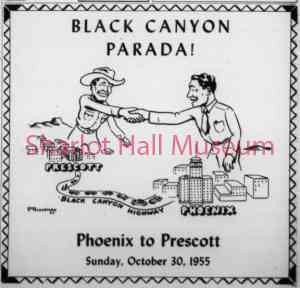By Worcester P. Bong
Driving on Interstate 17 and State Route 69 between Phoenix and Prescott routinely takes less than two hours. Today’s travelers don’t realize the backbone of these two highways was a stagecoach route known as Black Canyon Highway, which officially became a state highway in 1936, designated as Arizona State Route 69 (SR 69).
 The original route followed a Native American trail that wove north from Phoenix along the Agua Fria River. The route twisted through a gorge, up to a plateau and along the east side of the Bradshaw Mountains towards present-day Prescott. In 1864 part of this route between Dewey and Prescott was declared the first public road in the Arizona Territory. In the early 1870’s, by stagecoach, it was a rough thirty-hour ride from Phoenix to Cañon (today’s Black Canyon City), then to Prescott. There were steep climbs, dangerous river crossings and the threat of robbery. The elevation change was approximately 4,000 feet. Stagecoach stops included Bumble Bee and Gillette (now ghost towns), New River, Cordes, Mayer, Humboldt and Dewey. With the automobile’s emergence, the last stagecoach trips on the old route ended in 1917.
The original route followed a Native American trail that wove north from Phoenix along the Agua Fria River. The route twisted through a gorge, up to a plateau and along the east side of the Bradshaw Mountains towards present-day Prescott. In 1864 part of this route between Dewey and Prescott was declared the first public road in the Arizona Territory. In the early 1870’s, by stagecoach, it was a rough thirty-hour ride from Phoenix to Cañon (today’s Black Canyon City), then to Prescott. There were steep climbs, dangerous river crossings and the threat of robbery. The elevation change was approximately 4,000 feet. Stagecoach stops included Bumble Bee and Gillette (now ghost towns), New River, Cordes, Mayer, Humboldt and Dewey. With the automobile’s emergence, the last stagecoach trips on the old route ended in 1917.
To address automobile travel, in 1912 the Arizona State Highway Commission was formed. In the 1920s the commission established a formal Arizona highway system that was incorporated into the U.S. National highway numbering system. Arizona’s highways then became eligible to receive federal funding.
When funds became available, however, SR 69 took a backseat to Arizona State Route 89 which went from Phoenix to Prescott thru Wickenburg, Congress, Yarnell and White Spar. It was considered less costly to fund improvements for SR 89 than SR 69. This controversy and the funding decisions are described in the July 1925 issue of Arizona Highways.
 As for SR 69, it wasn’t until 1936 that road improvements began in earnest. The Works Progress Administration (WPA) funded improvements totaling $123,000 ($2.6 million today) on sections near Prescott and Bumble Bee. The project was postponed by World War II. After the war, construction restarted and the highway was realigned north of Black Canyon City and past Sunset Point.
As for SR 69, it wasn’t until 1936 that road improvements began in earnest. The Works Progress Administration (WPA) funded improvements totaling $123,000 ($2.6 million today) on sections near Prescott and Bumble Bee. The project was postponed by World War II. After the war, construction restarted and the highway was realigned north of Black Canyon City and past Sunset Point.
By the fall of 1955, SR 69 between Phoenix and Prescott was a fully dust-free paved roadway. To celebrate this milestone, plans for a “Parada” (parade or caravan of vehicles) were in the works. The headline in the August 22, 1955 Prescott Evening Courier read “Black Canyon ‘Parada’ is Planned Here”. Articles published on October 18th, 24th and 26th outlined the parada activities. The parada was eventually held on Sunday, October 30th. The October 31, 1955 edition of the Prescott Evening Courier reported on the dedication ceremony at Sunset Point. Caravans of automobiles driving from Phoenix and Prescott met at Sunset Point. The caravan then drove to Prescott for additional activities that included an air show at the Prescott airport.
 Sections of the old Black Canyon Highway still remain. Unpaved sections exist along the northern border of the Yavapai-Prescott Indian Reservation in Prescott, along SR 69 near Mortimer Farms, and north of Black Canyon City. Paved sections exist from the Prescott La Quinta Inn to Prescott Golf Club in Dewey and in Humboldt, Black Canyon City and Phoenix.
Sections of the old Black Canyon Highway still remain. Unpaved sections exist along the northern border of the Yavapai-Prescott Indian Reservation in Prescott, along SR 69 near Mortimer Farms, and north of Black Canyon City. Paved sections exist from the Prescott La Quinta Inn to Prescott Golf Club in Dewey and in Humboldt, Black Canyon City and Phoenix.
Less than one mile southeast from Prescott’s La Quinta Inn, you can visit a 1922 structure along old Black Canyon Highway, a 90-foot concrete bridge that crosses Lynx Creek. The August 17, 1922 edition of Arizona Highways noted this bridge was built to span Lynx Creek as part of improvements on Black Canyon Highway. This original bridge, parallel to a newer bridge, is now used as a walkway and is marked by an historic monument sign.
“Days Past” is a collaborative project of the Sharlot Hall Museum and the Prescott Corral of Westerners International (www.prescottcorral.org). This and other Days Past articles are also available at archives.sharlothallmuseum.org/articles/days-past-articles/1 The public is encouraged to submit proposed articles and inquiries to dayspast@sharlothallmuseum.orgPlease contact SHM Research Center reference desk at 928-277-2003, or via email at archivesrequest@sharlothallmuseum.org for information or assistance with photo requests.


